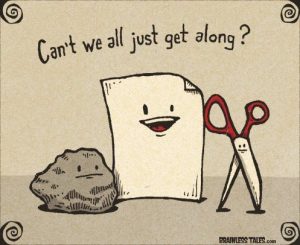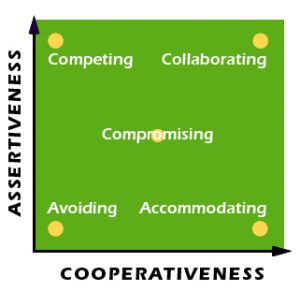Have you ever felt like someone at the office hates you for no reason? And, that you haven’t done EVERYTHING on your side to get along with this person (because, of course, you have such a good heart), but nothing changes?
Well, when you’re having a conflict with a teammate or with the whole the team, studies have revealed that it may be you, not them!
I apologize if I’ve hurt your feelings, but it’s the experts talking, not me… Though, let’s not talk about who’s fault it is, let’s focus on how to deal with the conflict.
A little disclaimer for this post: I’ll like to suggest that you guys to keep an open mind, sometimes it’s not easy to accept our mistakes, nonetheless, take this as an opportunity to improve. “Don’t fear conflict; embrace it”.
First of all, you’re probably wondering, Why do I need to interact with other people at the office? and Why do I need to build relationships at work? Very easy, we’re social creatures, we need interaction with other persons to survive, and we need each other to build a successful product or to complete a project. As they say: “None of Us is as Good as All of Us“… Not enough? OK, what if I tell you that most people spend about 80% of their careers in the same field which means you will end up crossing paths with the same people over time, you’ll share the same journey, having good team relationships with these people will prevent you from committing career suicide. Better? Did I persuade you to at least reconsider it? Of course, this doesn’t mean that we need to be best friends with everyone, not at all, not with all of them.
In every workplace, conflicts are inevitable, everyone has their own personality, culture, we all grew on different environments, have different ages and maybe different nationalities, all of this contributes to conflict; It’s not always bad, conflicts can be constructive if they encourage creativity or improvement, but, sadly, we’ re here to talk about the bad, the sad, the want to slap you in the face kind of conflicts.

So tell me then, what can cause a conflict? The main sources of conflicts include: poor communication, different values, conflicting interests and personality clashes amidst others. And, the most common consequence of conflicts is stress, which can leads to insatisfaction, anxiety, anger, low productivity, missed deadlines and in some cases, quitting the job.

So before we get depressed, let’s move on and talk about how to deal with conflicts. First and foremost, you need to acknowledge the problem, recognize that something is not right and needs to be fixed. Don’t wait too much to take care of the conflict, it’ll be easier to solve it on an early stage rather than let it grow into something bigger.
I’m not going to list a set of steps that you should follow canonically, instead, I’m going to share some ideas that you can easily apply in real life. Take a deep breath and ask yourself:
- What upsets me about this person?
- Why is it affecting me so much?
This will give you a perspective and, maybe it could end the whole conflict now that you have realized that there’s no real reason to be affected by this person. Maybe he or she, wasn’t even talking about you when you overheard that conversation that upset you so much (do I speak from a personal experience? you’ll never know!).
If at this point, you’re still upset by this person, you’ll need to bring the problem to the table, talk with this person in a quiet environment; But!, don’t do it just yet, before you do so, be sure that you’re calm and prepared, clear your head, take a walk or a glass of wine (only if it’s past 5:00 pm, OK?), now go… Once you’re talking, stay professional and respectful, talk about the facts (not the rumors), let the other person talk and LISTEN carefully. Then, try to identify a common area that could lead you guys to an agreement. Remember that the objective is not just talk about the problem, the goal is to find a way to solve it. Some things to consider:
- Your way is not always the right way (unless you’re me, bad joke? OK, sorry).
- People have different points of view and in a way they are all valid.
- As much as possible don’t “you” each other as in, “You always …” or “You never…”
- Be clear and precise when communicating what is it that upsets you.
- Don’t interrupt the other person.
- Avoid taking an aggressive tone.
- Don’t allow yourself or the other person get distracted from the original point of the conversation.
- Agree on follow-up steps and do what you both agreed to do.

By this point, You may be thinking, do I really need to do this every time something or someone upsets me? Luckily, you don’t have to. You just need to take a look at the chart below, called TKI, this shows us five common strategies or styles for dealing with conflict, you can easily apply these styles in your daily life at work.

As you can see, in the X axis we have the Cooperativeness: the extent to which the person attempts to satisfy the other person’s concerns. and in the Y axis we have Assertiveness: which relates to behaviors intended to satisfy one’s own concerns.
Competitive (assertive and uncooperative): Win the conflict at all costs, at the end, you’re not concerned about maintaining this relationship for a long time.
Avoidance (unassertive and uncooperative): Ignore the conflict, in other words, put it on flight mode, as simple as that.
Collaborate (assertive and cooperative): You’ll be having an ongoing relationship with this person, then, you’ll need to work closely and seek for a win-win resolution to the conflict.
Compromise (middle ground between being assertive and cooperative): When time is short and you need to find a practical way to work together, each side has to give up on something.
Accommodating (unassertive and cooperative): In this situation, the relationship takes priority, you might have to postpone on getting what you want to maintain harmony. Sorry, life is not always fair!
I learned about these techniques not too long ago (shame, right?), and I have found myself applying them very often. I encourage you to start using them as you see fit, it takes time to be able to recognize in which category you can put each conflict, but as long as you keep practicing, you’ll get better at it!
Before I let you go, I know that there’re cases when the conflict goes beyond your control and you can’t really do anything about it… For those cases, there’s also a technique called “Escalation”, but that it’s whole other topic, one that I’ll write about in a future post, so stay tuned! In the mean time, here is a quick tip:

sources: http://hrcouncil.cahttp://www.kilmanndiagnostics.com/https://www.thebalance.com/https://training.businessmanagementdaily.comhttp://talentplus.comhttps://www.businessknowhow.comhttps://money.usnews.comhttps://jobs.telegraph.co.ukhttps://hr.ou.eduhttps://hiring.monster.co.uk/


